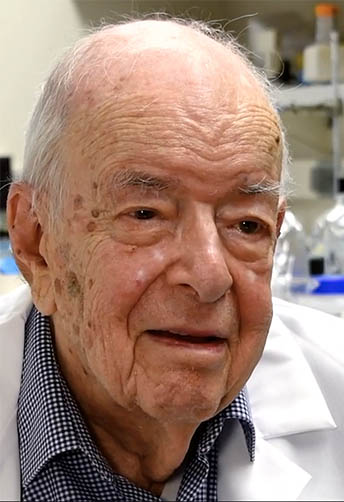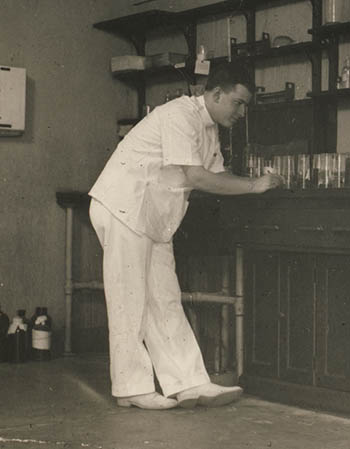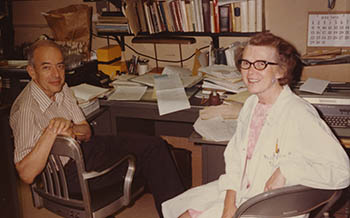Herb Tabor (1918–2020)
Longest-serving NIH Employee Dies at 101
We are sad to relay news of the passing of Herbert Tabor, M.D., the world’s foremost authority on the enzymatic pathways of polyamines, as well as an esteemed editor of the Journal of Biological Chemistry (JBC) for 40 years, and, until his death at age 101, a senior principal investigator in the NIDDK Laboratory of Biochemistry and Genetics, where he had served as lab chief until 1999. He died peacefully in his sleep, on August 20, 2020, at his home on the NIH campus.

Herb Tabor being interviewed for an oral history in 2019.
Herb, along with his wife, Celia, also a physician-scientist, who died in 2012, revealed the multitude of functions served by polyamines, organic compounds that interact with DNA, RNA, and proteins. The Tabors demonstrated that polyamines are required for growth of most organisms; protect against oxidative damage, elevated temperatures, and other environmental insults; and help maintain mitochondria and the fidelity of protein biosynthesis.
He was a consummate scientist to the very end, working remotely on research papers with NIH colleagues. Aside from leaving a profound scientific legacy, he was the last living voice of the NIH’s formative years, having arrived in 1943 to the then–recently created Bethesda campus.
It’s such a great loss for the NIH and broader scientific community of a warm, humble, insightful, and imaginative man. Herb was truly loved and respected by everyone who worked with him, at the NIH and beyond.
Herb was born in New York City on November 28, 1918, coincidentally in the midst of a pandemic. He came of age during the Great Depression and attended local public schools. Showing a clear propensity for science, he received his undergraduate degree from Harvard University (Cambridge, Massachusetts) in biochemical science in 1937 and then his M.D. from Harvard Medical School (Boston) in 1941.
At Harvard, Herb was encouraged by his professors to pursue a career in biochemistry rather than clinical practice. During an internship at Yale–New Haven Hospital in 1942, however, Herb was exposed to both the clinical and biochemical worlds, including the first major clinical trial for penicillin, which would prove crucial in saving the lives of soldiers fighting in what would soon be labeled World War II.
Herb relayed the moment years later: “I was the intern at the time and performed the actual injection. The patient had a severe streptococcal septicemia with a persistently elevated temperature. Even though the dose of penicillin used was minimal by current standards, the therapeutic effect was dramatic, resulting in a rapid and permanent fall in temperature to normal.”
In 1943, with the United States at war, Herb entered the U.S. Public Health Service and was assigned as the sole medical officer on the USCGC Duane, a Coast Guard cutter that sailed between the United States and England guarding convoys taking supplies to the British Isles. After one battle at sea, when the Duane sank a German submarine and captured its crew, Herb provided medical care to rescued Allied sailors whose ship had just been sunk by the submarine as well as to captured German sailors. As that long year wound down, Herb was transferred to the NIH, working under the supervision of Sanford M. Rosenthal, M.D., chief of the Laboratory of Pharmacology and Toxicology at the National Institute of Arthritis and Metabolic Diseases. Together they studied electrolyte changes in burns and traumatic shock and determined how to treat such injury using saline instead of plasma, as plasma was in very short supply.

Herb Tabor in his lab (1942).
Mingled in this time was Herb’s new relationship with Celia White, whom he had met in 1940 when a mutual acquaintance introduced them on a Boston streetcar. They were married in 1946 after Celia had finished her medical training; and they started working together at the NIH in 1952, collaborating on studies on various aspects of the biosynthesis and function of polyamines. Herb succeeded Rosenthal as lab chief in 1962. The Tabors were one of a few scientific couples working side by side at the NIH, as most universities had rules that prevented married couples from working together. The Tabors lived in commissioned officer housing on the NIH Bethesda campus and raised four children.

Herb and Celia Tabor (1972).
No summary of Herb’s achievements is complete without mention of his role with the JBC. Herb joined the JBC editorial board in 1961, and he became associate editor in 1968 and editor-in-chief in 1971, a position he held until 2010. Herb oversaw the journal’s expansion from 1,000 to 4,500 published articles per year, and he was the moving force behind its transition to online publishing in 1995. He also created the Minireview Compendium, a yearly compilation of all short reviews published in the JBC. In 2011, in honor of Herb’s scientific and editorial legacy, the JBC established the Herbert Tabor Young Investigator Awards to recognize early-career first authors of standout JBC papers for their creativity and scientific excellence. (Similarly, the Herbert Tabor Research Award from the American Society for Biochemistry and Molecular Biology, established in 2004, honors senior investigators.)
Herb’s honors are many. He received the Arthur S. Flemming Award in 1956; received the U.S. Public Health Service Meritorious Service Medal in 1970; was elected to the American Academy of Arts and Sciences in 1971; was elected to the National Academy of Sciences in 1977; received the Hillebrand Prize from the American Chemical Society in 1986; and received the William C. Rose Award (with Celia) from the American Society for Biochemistry and Molecular Biology in 1994. In honor of his 100th birthday, Montgomery County (Maryland) proclaimed November 28, 2018, as Dr. Herbert Tabor Day.
Herb was the longest-serving NIH employee; its oldest principal investigator; and possibly, with 77.5 years under his belt, the longest-serving current federal employee at the time of his death.
The list of scientists whom Herb mentored is longer than his years of life. One of the many is Reed Wickner, who trained under Herb and succeeded him as chief of the Laboratory of Biochemistry and Genetics in 1999. “Herb taught me how to do science, and his devotion to science set a standard for me to aspire to,” Reed said of his mentor. “His gentle sincerity combined with forthright critical thinking made him a leader throughout his career.”
Herb is survived by four children—Edward, Marilyn, Richard, and Stanley—as well as 10 grandchildren and 6 greatgrandchildren. To learn more about Herb’s life, we suggest the journal article “It All Started on a Streetcar in Boston” by Celia and Herb Tabor (Ann Rev Biochem 68:1-32, 1999) and also Herb’s 2019 video–oral history by NIDDK and the Office of NIH History.
The ongoing COVID-19 pandemic has limited the family’s ability to hold memorial services. In lieu of flowers, donations are welcome in Herb’s name to The Children’s Inn at NIH. We will keep you informed about any NIH plans next year—in person, together again—to remember and salute Herb Tabor.
Michael M. Gottesman, M.D., Deputy Director for Intramural Research, NIH
Griffin P. Rodgers, M.D., M.A.C.P., Director, National Institute of Diabetes and Digestive and Kidney Diseases
This page was last updated on Tuesday, March 22, 2022
